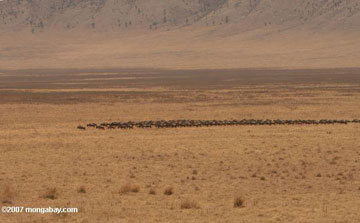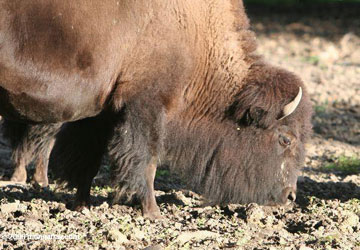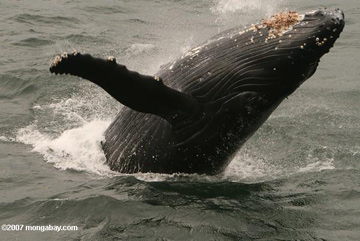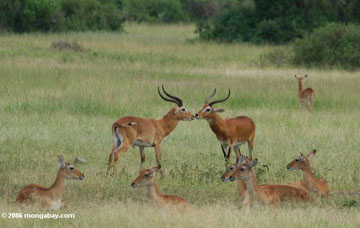The end of migrations: wildlife’s greatest spectacle is critically endangered
The end of migrations: wildlife’s greatest spectacle is critically endangered
Jeremy Hance, mongabay.com
July 28, 2008
Why abundance matters: the conservation of migrations would preserve important ecosystem services
|
|
If we could turn back the clock about 200 years, one could watch as millions of whales swam along their migration routes. Around 150 years ago, one could witness bison filling the vast America prairie or a billion passenger pigeons blotting out the sky for days. Only a few decades back and a million saiga antelope could be seen crossing the plains of Asia.
Fast-forward to today and the humpback whale population is less than 2 percent of its estimated historic population, from 1.5 million behemoths to 20,000. Only 350,000 bison are left out of a population that may have reached 100 million; their percentage remaining is not even a whole number. The saiga antelope has dropped 95 percent in twenty years, from a million individuals to 50,000. But the passenger pigeon proves the most drastic, going from one of the world’s most populous bird to extinct in a few decades. These examples illustrate a common occurrence: the phenomenon of mass-migration is going the way of the passenger pigeon. From whales and sea turtles to insects and song-birds, from hoofed mammals to the predators that track them, massive migrations are declining worldwide. In an essay in PLoS Biology, scientists David S. Wilcove and Marin Wikelski discuss the ramifications of these losses in abundance and the importance of new conservation attention on the beleaguered migrants.
 Wildebeest in Tanzania. Photo by R. Butler |
The writers describe four major reasons why massive migrations are gravely threatened: human-created barriers like dams, fences, and roads; habitat destruction; climate change; and overexploitation of a species, particularly important in the case of oceanic and fresh-water migrants. All of these reasons are anthropogenic (human-related). But, Wilcove and Wikelski believe that those who caused the demise of the great migrations could also save them. The authors argue that the world’s great migrations deserve large-scale conservation initiatives. In fact they state that mass-migrations should be protected much like endangered species. But unlike endangered species massive populations must be preserved of the migrating species to warrant success, while a few healthy breeding pairs can be enough for the recovery of an endangered species.
Although no one knows exactly how each migration affects its ecosystem, the authors believe that the diminishing of such migrations drastically alters the productivity of an ecosystem, challenging its ability to provide essential services. For example, the authors illustrate that salmon “by migrating upstream, spawning, and dying, transfer nutrients from the ocean to the rivers. A portion of the nutrients is delivered in the form of feces, sperm, and eggs from the living fish; much more comes from the decaying carcasses of the adults. Phosphorus and nitrogen from salmon carcasses enhance the growth of phytoplankton and zooplankton in the rivers, which provide food for smaller fish, including young salmon.” However, the Northwestern rivers of America, receive only about 6-7 percent of the nutrients they once did due to a drastic decline in the migratory population of salmon. Fewer nutrients ultimately lead to less salmon in the next generation and less biomass altogether.
 American Bison. Photo by R. Butler |
It is not just one-species migrations, such as salmon and saiga antelope that suffer from decline. “Even the less iconic migrations show signs of trouble,” the authors write. “Birdwatchers in North America and Europe, for example, complain that fewer songbirds are returning each spring from their winter quarters in Latin America and Africa, respectively.” The authors cite a recent study of Europe’s birds, which show migratory birds have suffered greater declines in population than stationary species. Such drops in population are also bound to have drastic impact on ecosystems. One example, provided by the authors, is migratory birds’ importance in controlling insect populations in forest. Fewer birds may mean a population-explosion of insects, some of which could be detrimental to the forests or nearby rural land. In fact, a 2005 study of the passenger pigeon’s extinction argued that the bird’s demise caused the current prevalence of Lyme disease. Noting that deer ticks, which spread Lyme’s disease, and passenger pigeons both competed for the same food-source, acorns, the researchers concluded that the loss of passenger pigeons caused an incomprehensible rise in the deer tick population due to a steadfast acorn surplus.
Preserving thousands to millions of individuals will not be easy. The scientists write that saving these migrations will pose “unique scientific and social challenges”. How does one approach preserving abundance, rather than settling for simple existence? The writers believe that protecting migrations will require action on the local, national, and global level. Those in power will have to change their mindset and protect a species before its population declines.
 Humpack whale in Alaska. Photo by R. Butler |
“If we are successful,” Wilcove and Wikelski write, “it will be because governments and individuals have learned to act proactively and cooperatively to address environmental problems, and because we have created an international network of protected areas that is capable of sustaining much of the planet’s natural diversity.”
The authors believe it will be well worth the energy and sacrifices required, considering the ecological services provided by these massive movements, the scientific importance of studying the mechanisms behind such migrations, and the perfect wonder of such spectacles. Such migrations are a kind of culmination of Nature’s potential—once so prevalent across the world, now only surviving in a few aberrant places.
Some great migrations do remain. Butterflies still cross international boundaries in astounding numbers. Every May, over a million wildebeests travel across the African plains, providing food for many of the Africa’s large predators, from lions to hyenas to crocodiles. Caribou still migrate in the thousands across the Arctic tundra. And only a year ago an unknown migration was observed in the Southern Sudan, with over a million antelopes, including the white-eared kob, the tiang, and the mongalla gazelle. Conservationist and adventurer, Michael Fay, said of the discovery: “This could represent the biggest migration of large mammals on Earth. I have never seen wildlife in such numbers, not even when flying over the mass migrations of the Serengeti.”
 Ugandan Kob. Photo by R. Butler |
Although on the wane, great migrations still exist: the discovery of a new migration, containing a million individuals, buoys that point. Now, with proactive attention, with great energy and global cooperation, such migrations could not only survive, but thrive. In the future—as in the past—millions of whales, saiga antelopes, and even bison could move along migratory routes, completing their ecological role.
Wilcove DS, Wikelski M (2008) Going, going, gone: Is animal migration disappearing? PLoS Biol 6(7): e188. doi:10.1371/journal.pbio.0060188